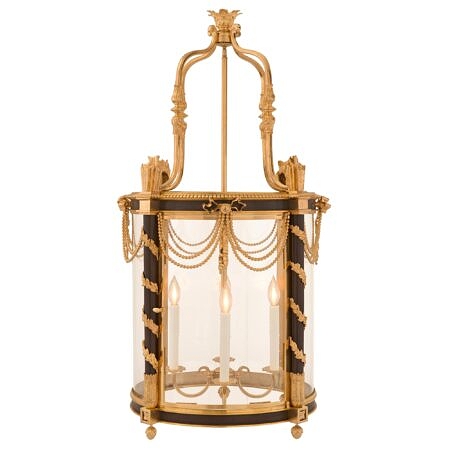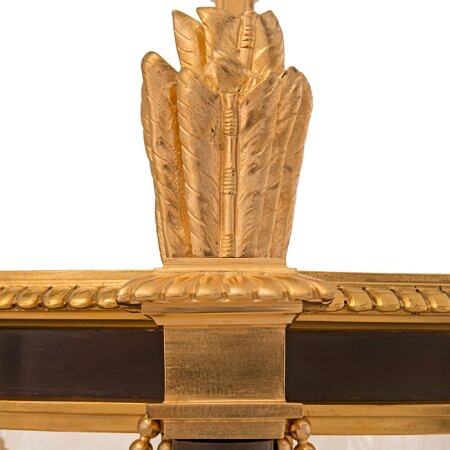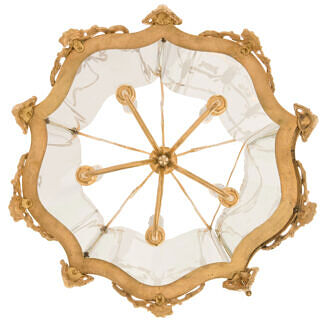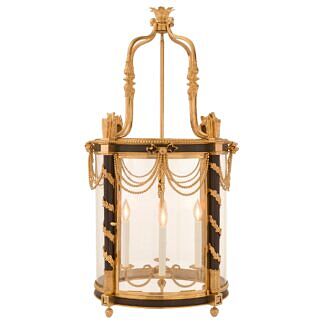A French 19th century Louis XVI st. Belle Époque period patinated bronze and ormolu lantern signed Vian
Sorry, This item has sold
A striking and very high quality French 19th century Louis XVI st. Belle Époque period patinated bronze and ormolu lantern signed Vian. The lantern displays four charming finely detailed bottom acorn finials below lovely block rosettes and beautiful column like... — Read More
A striking and very high quality French 19th century Louis XVI st. Belle Époque period patinated bronze and ormolu lantern signed Vian. The lantern displays four charming finely detailed bottom acorn finials below lovely block rosettes and beautiful column like supports leading upwards decorated with elegant wrap around berried laurel branches. The chandelier retains its four original curved glass panes with a door at the front which opens via its original lock and ormolu handle to access the four curved arms with candle cups. The surrounding column like supports is adorned with richly chased fletchings, a wrap around reeded band, and charming most decorative ribbons amidst fine beaded swaging garlands. Four scrolled supports with foliate accents lead upwards to the top foliate canopy.
Henry Vian (1860-1905) was a celebrated bronzier who specialized in the production of bronzes in the eighteenth century style, particularly light fittings, cases with bronze mounts and chandeliers of great quality. He participated in the Great Exhibition of 1878, 1889, and 1900 and received a Gold Medal in 1889. His workshop was based at 5 rue de Thorigny in Paris. His wife and son ran the business after his death in 1905 until 1944, when the city of Paris took over the premises for the Ecole des Métiers d'Art. — Read Less
- Weight: 78 lbs / 35.373 kg
Shades, Canopies and Chain shown for display purposes, sold separately.
- Item # 12200
-
H: 44 in L: 23.5 in D: 23.5 in
H: 112 cm L: 60 cm D: 60 cm
- France
- 19th Century
- Ormolu, Patinated Bronze
-
Belle Époque Read More,
Louis XVI st. Read More
(Belle Époque) -
Gaining its name from the optimistic and peaceful period of time between 1871 and World War I, Belle Epoque means “beautiful period”, and occurred during the era of the Third French Republic. This period of economic, colonial, and scientific prosperity brought with it a flourishing artistic climate with numerous literal, musical, theatrical, and visual masterpieces being created.
The Eiffel Tower, which was constructed between 1887 and 1889, served as the entrance to the World’s Fair held in Paris. That same year, the Moulin Rouge cabaret in Paris was founded and showcased the now more mainstream styles of performance including can-can dancing. Belle Epoque dancers and singers were Paris celebrities and became immortalized by the poster arts of Toulouse-Lautrec.
Leading up to this period in 1865, the American Civil War was coming to a close, with France proposing to construct the Statue of Liberty as a joint effort with the United States. France would be responsible for the statue, with America constructing the pedestal. Created to celebrate the nation’s success in building a viable democracy, the statue would stand as a symbol of friendship between the French and American people.
(Louis XVI st.) -
Also known as Louis Seize, Louis XVI's style is a style of architecture, furniture, decoration, and art created during Louis XVI’s 19-year reign in France, just before the French Revolution.
Thought to be a reaction and juxtaposition to the prior more elaborate styles, Louis XVI style developed at the end of the Baroque Period and continued until the birth of French Neoclassicism.
King Louis XVI showed little enthusiasm for the old world styles of the Baroque Period and he sought out a create a new “beau ideal” that focused on the purity and grandeur of Ancient Romans and Greeks.
Inspired by Ancient Roman architecture and art, distinct features of the Louis XVI style are linear lines, small repeated motifs, floral medallions hanging from ribbons, acanthus leaves, urns, dolphins, ram, and lion heads, and griffins.
Greco-Roman elements, often used in earlier and later French styles, were also quick common and included fluted and twisted columns, Caryathids, and corbels.
- Henry Vian Read More
Henry Vian (1860-1905) was a celebrated bronzier who specialized in the production of bronzes in the eighteenth century style, particularly light fittings, cases with bronze mounts and chandeliers of great quality. He participated in the Great Exhibition of 1878, 1889 and 1900 and received a Gold Medal in 1889. His workshop was based at 5 rue de Thorigny in Paris. His wife and son ran the business after his death in 1905 until 1944, when the city of Paris took over the premises for the l'Ecole des Métiers d'Art.
Payment Plan Option Learn More Choose the payment plan option at checkout and customize this payment option with our team. Payment plans are flexible and items will ship once all payments are received.































